Leeham News and Analysis
There's more to real news than a news release.
Leeham News and Analysis
Visit to Bombardier for airBaltic CS300 roll-out
By Bjorn Fehrm
October 27, 2016, ©. Leeham Co: This week we have been at Bombardier (BBD) Mirabel Airport outside Montreal to observe the roll out of the airBaltic CS300 CSeries model and to later test fly the aircraft at BBD’s Wichita facility.
The preparation for the test flight and the flying experience will be described in subsequent articles.
airBaltic will take delivery of the first CS300 by the end of November. This event was for Baltic media to see the aircraft and its final livery for the first time. It was fresh from the paint shop. The group also was able to see the CSeries Final Assembly Line (FAL) and to ask questions to airBaltic CEO Martin Gauss.
airBaltic CS300 roll out
No-one had seen the final painting of the aircraft before the roll-out. The aircraft had been towed from the paint hangar the day before under darkness. As airBaltic wants to keep the final interior layout under wraps, we were not allowed to enter the aircraft.
Bombardier Mirabel
Bombardier’s Mirabel facility lies a 45min car ride north of Montreal. It’s a very modern facility which houses the FALs for the Commercial Aircraft jets, the CRJ and CSeries, Figure 2.
The front of the building gives space for administration functions, among them the new Customer Response Center. There, groups for CRJ and CSeries jets assist airlines 24/7, 365 days a year with any questions or issues they have.
Central to the new facility was the status wall which showed operational aircraft and the status of logged calls with the center, Figure 3.
The CSeries group was up to full strength (about 15 people working in three shifts) despite there being only three CS100 in operation now with SWISS Airlines. The Center manager said this is in no way reflecting on the level of issues for the aircraft. The initial operational experience is very good. It’s rather an opportunity to train people into the job and to get the supporting specialist groups up to speed before SWISS, airBaltic and other operators come up to full speed.
The CRJ group handles 1,500 operational aircraft. It was a bit larger than the CSeries group, but not much. The CRJ is a mature aircraft with experienced operators running an aircraft with high operational reliability.
Final Assembly Lines
The building also contained the CSeries FAL on the back side, Figure 4. There, two lines of CS100 and CS300 get assembled. The pacing of the 100 and 300 models on the line is totally flexible. From an assembly perspective, they are virtually identical, differing only by fuselage length.
The FAL contains an entry section where system-stuffed fuselage sections get joined into a complete fuselage, Figure 5.
The join operation is taking place in the left-most fuselage position by four towers with BBD-developed robots that automatically drills the holes, deburrs them and then adds the fasteners.
Fuselage and wing/tailplane joins are all done with a hall-based GPS reference system which is so accurate that no subsequent aileron or rudder trimming of the aircraft is necessary. This results in about a one percent performance gain compared to conventional methods, explained CSeries VP Rob Dewar, as the there is no drag from compensating flight surfaces.
Right now, the CSeries is constrained in its delivery schedule by missing Pratt & Whitney (PW) PW1500G engines. Dewar said that production is kept at planned pace and aircraft even gets engines installed without fan blades (which is the time critical item for PW) for the blades to get installed later.
airBaltic selection of CS300
We got the chance to ask airBaltic CEO Martin Gauss about the selection of CSeries CS300 to replace their Boeing 737-300 and -500 aircraft. Gauss explained that the airline invited Boeing and Airbus during 2012 to present what they could offer as replacement. Bombardier was also invited, as the airline was an operator for the BBD Q400 aircraft.
“The evaluation showed that the CS300 was the best aircraft to replace the 737-300 and -500 that we operated,” said Gauss. “The subsequent order of 10 CS300 (which has now been raised to 20) was based on BBD’s promised performance for the aircraft.”
“With the CS300 certification testing now complete, the aircraft has met or exceeded what was promised to us at the time,” said Gauss. “So should we do the evaluation today, the result would have been the same. The CS300 is an ideal aircraft for our present and future operational plans.”
Share this:
- Click to print (Opens in new window) Print
- Click to email a link to a friend (Opens in new window) Email
- Click to share on X (Opens in new window) X
- Click to share on Pinterest (Opens in new window) Pinterest
- Click to share on Facebook (Opens in new window) Facebook
- Click to share on WhatsApp (Opens in new window) WhatsApp
- Click to share on LinkedIn (Opens in new window) LinkedIn
- Click to share on Tumblr (Opens in new window) Tumblr
- Click to share on Reddit (Opens in new window) Reddit
Related
Category: Airbus, Airlines, Boeing, Bombardier, CSeries, Pratt & Whitney
Tags: Airbus, Boeing, Bombardier, CS300, CSeries, Pratt & Whitney GTF


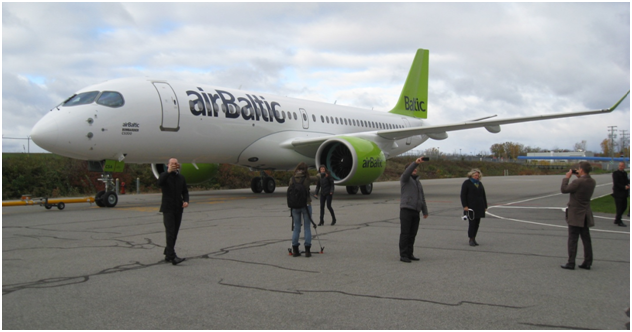
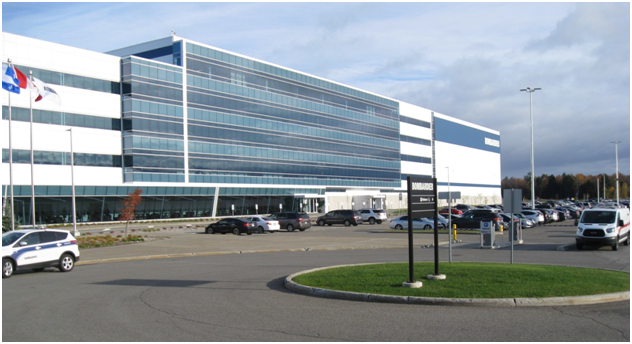
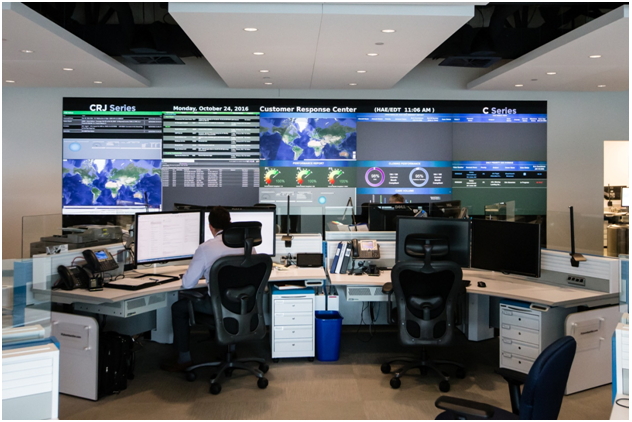
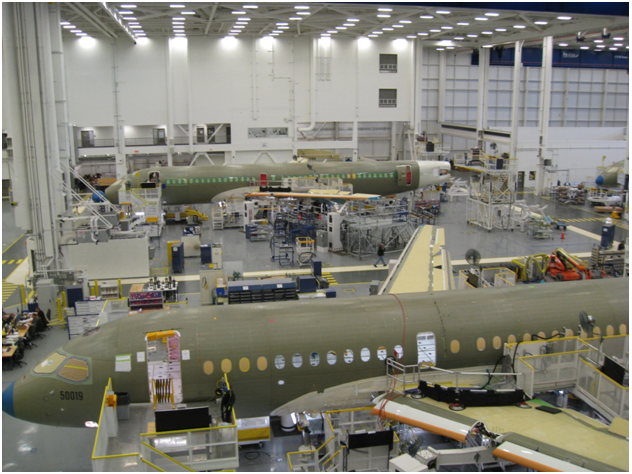
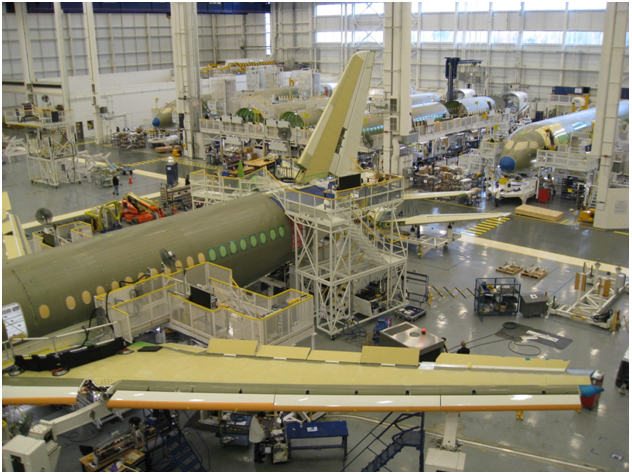
Nice look behind the scenes. Looking forward to your further reports. Hopefully the PW1500s start rolling in soon.
“Fuselage and wing/tailplane joins are all done with a hall-based GPS reference system”
Very instructive, but I am very curious to understand how such a result can be achieved given the GPS accuracy (even with military accuracy)?
As far as I remember, at least for A330/340 family) Airbus uses laser beams and references plots purposely fixed at critical loactions on wing and fuselage to perform the assembly, still not an easy job but which seems more accurate to me…
I think the answer to your question is in the original statement. The system, however it works, is hall based not space based. Methinks the term GPS here is being used in a generic sense.
You are absolutely right Dan. According to Wikipedia there are at least seventeen types of position sensors currently available. Laser beams, as referred to by Alban in his post, and the Hall sensors that are used by Bombardier, are among the seventeen types listed below in alphabetic order:
Capacitive transducer
Capacitive displacement sensor
Eddy-current sensor
Grating sensor
Hall effect sensor
Inductive non-contact position sensors
Laser Doppler Vibrometer
Linear variable differential transformer
Multi-axis displacement transducer
Photodiode array
Piezo-electric transducer
Potentiometer
Proximity sensor
Rotary encoder
Seismic displacement pick-up
String potentiometer
Ultrasonic sensor
Thanks Normand and Dan for your answers and correcting me. I just focused on “GPS”… too quickly!
Nice achievement from Bombardier if the process proves to be reliable through the time.
The C Series is twice the size of the CRJ, yet it takes half as many people to assemble it. Robots were implemented before the first sub-assemblies arrived on site. My understanding is that they tested the system, and the new assembly techniques that come with it, in a dedicated location called Hangar Y, before going into actual production. It seems to work very well, because it takes less time to assemble the aircraft than what was initially expected for this stage. If things continue to progress the way they do presently, instead of a rate of 120 aircraft per year they are now considering as much as 150 per year, were the number of orders high enough to justify it. And there are provisions to double the current installations, which could bring the production rate up to a maximum of 300 aircraft per year. Providing Pratt & Whitney can supply its engines in sufficient numbers…
Boeing’s offer has changed (the 737-7 is now 12 seats bigger). The economics of comparable aircraft have therefore changed. Perhaps the CS300 would still win or is better suited because the yield management is easier with a smaller cabin or perhaps not. Real question is how the capital costs of a new aircraft and the uncertainty of EIS will help an airline in the position that Air Baltic faces. Threats from other LCC with lower costs. Economic challenges of the region etc…
“Boeing’s offer has changed (the 737-7 is now 12 seats bigger).”
Bombardier’s own offer could also change with the forthcoming CS500.
I think the real answer is it does not matter.
I have said all along, why would you buy a heavy boat when you need a light one?
Weight is an on going penalty as is fuel burn an on going plus.
Boeing and Airbus could seduce the big operators as it folds into a larger overall picture, small ones need the best they can get straight up front.
@ Dark Horse
The C-Series is a much more modern plane with better passenger comfort, better aerodynamics, lower weight (CFRP-wings), full FBW, less cabin noise, better take-off performance. It all ads up to a more efficient plane that pleases the passengers. How much better could it get?
The only way for Boeing to beat Bombardier is by discounting the 737 heavily, somewhere near production cost, which they probably did not do with AirBaltic.
The BBD plane is probably competitive, but the financing provided by EDC is probably the biggest deal. Euro export bank cannot lend to Europeans and EXIM is currently shut down. So BBD can go make hay in the USA and Europe. The Delta deal has a lot to do with this as well.
‘Fuselage and wing/tailplane joins are all done with a hall-based GPS reference system which is so accurate that no subsequent aileron or rudder trimming of the aircraft is necessary. This results in about a one percent performance gain compared to conventional methods, explained CSeries VP Rob Dewar, as the there is no drag from compensating flight surfaces.’
Wow, are current methods used by competitors really so hit and miss?
Yep, read the issues with both the 787 and A380 with shims.
“The group also was able to see the CSeries Final Assembly Line (FAL).”
Bjorn, could you please ask Bombardier when they will start building a proper Final Assembly Line. Because what everyone calls the FAL is actually the initial assembly building where the aircraft is put together before being sent to a temporary FAL located across the tarmac in a few specially modified CRJ hangars. This arrangement is not sustainable for higher production rates.
“The pacing of the 100 and 300 models on the line is totally flexible. From an assembly perspective, they are virtually identical, differing only by fuselage length.”
It will be the same for the CS500, which will fit on the same two initial assembly lines. My understanding is that the CS700 or CS900 would not fit on the same lines though and would therefore have to be assembled in an adjacent facility that could eventually be built in order to double the production capacity. From what I have seen in an illustration of the future assembly complex, this new facility appears to be slightly longer and would therefore accommodate any longer variant above the CS500.
“Production is kept at planned pace and aircraft even gets engines installed without fan blades (which is the time critical item for PW) for the blades to get installed later.”
This means they will accumulate several white tails, unless the aircraft are shipped to their respective customers in containers. Airbus has the same problem.
White tails ? Thats generally means built with no customer? Perhaps we can invent a term that means ‘built for customer but waiting for engine’
“White tails ? Thats generally means built with no customer?”
Correct, and I believe the exact opposite would actually take place at Boeing for example, since we would likely see a bunch of unpainted aircraft with well identified pre-painted tails on white fuselages. I am not sure, but I think Bombardier keeps the tails “natural” until the entire aircraft is sent to the paint shop after completion. Natural in this case means green. But for the C Series I don’t know if the aircraft would be fully completed, waiting for their fan blades, before going out for a ground run and test flight; or if they would get painted later on. Technically we cannot call them “white tails”, but what should we call them if they keep accumulating? If they are painted we cannot say they are green aircraft. And if they are finished, but without fan blades, we cannot say they are unfinished aircraft either. So, I suggest we simply call them undelivered aircraft.
Pratt Tails?
Perhaps they should change their name for the Parked & Waiting engine company. But then they would also need to change their trademark:
Old: PRATT & WHITNEY DEPENDABLE ENGINES
New: PARKED & WAITING DEEPINTROUBLE ENGINES
CS100 – 35m
CS300 – 39m
CS500 – 42m?
CS700 – 45m?
CS900 – 48m?
As far as rotation angle, I could see the CS700, but the CS900 is a bit of a stretch.
I agree, the CS900 is highly unlikely. But so was the CRJ-1000. And Boeing is reportedly working on a 777-10. Not to forget the 737 MAX 10. All were, are, or will be, a bridge too far.
https://www.google.ca/search?q=Bombardier+C+Series+CS500&safe=off&biw=1488&bih=850&source=lnms&tbm=isch&sa=X&ved=0ahUKEwj8lbvOxfzPAhXJaT4KHcSSBNcQ_AUIBygC#imgrc=_woyVo5P_aO_sM%3A
Hi Normand,
sorry for late answer, was busy test flying the CS300 this week, articles will come. BBD has the FAL in the hall I showed. Then they do the system checks and hangs the engines in another hall that I also visited, at the south-west end of the joint buildings. This is exactly like Airbus does for the A350.
Why would this be done on the line? And why would it limit a production rate? You can’t combine things that take dramatically different times on a line.
And its not white tails, that is speculative production without customers. The CSeries that gets produced have all customers, just not engines.
They will not be white tails as they will be painted in customer colours. But they will be parked until the factory in Singapore can spit out the fans.
I was using the expression in a loose sense and as a generic term for aircraft that are already manufactured but cannot be delivered. But technically it was incorrect and I have already acknowledged this in a previous post. Since you are the third person after dukeofurl and Bjorn to point this out to me it is becoming increasingly clear for me that I should not have taken for granted that people would understand what I meant.
B737-7 vs Bombardier A300
http://planes.axlegeeks.com/compare/267-300/Boeing-737-700-vs-Bombardier-CS300
You got that wrong Claude. Your comparison is between the 737-700 and CS300. The MAX 7 would not only carry 12 more seats but it would also have the Leap engine. The 737-700 and the MAX 7 are very different aircraft, and that makes your comparison unfair. Besides, I wouldn’t consider axlegeeks a reference by any measure.
Go BBD.
ALERT: Reuters has just reported UPS has placed an order for 14 B747-8Fs with a list price of 5.3 Billion! Options for 14 more! Congratulations BA!
@Bjorn Fehrm
“Was busy test flying the CS300 this week.”
That is exactly what I thought you were doing, and I look forward to read your report. Other than customer’s pilots and BBD’s own test pilots, very few people had this privilege.
“Why would this be done on the line? And why would it limit a production rate? You can’t combine things that take dramatically different times on a line.”
The present setup is fine as long as production rates are low. The big hall you have visited is an initial assembly hall; it has two lines and is geared for very high production rates. As production ramps up and they get on the other side of the learning curve, the modified CRJ hangars that they use as a temporary FAL will become a bottleneck. I don’t know at what rate this will start to happen; all I know is that at 120 or 150 aircraft a year it is unsustainable. In the following paragraph I explain what they have planned for in order to achieve higher rates and high productivity.
The real FAL, the one no one talks about, is meant to be built west of the big assembly hall where the initial assembly of the C Series already takes place. This FAL will be built contiguously to the existing P&W engine build-up facility that has been erected a few years ago to prepare the engines for installation on the aircraft. In this small building the engine is attached to the pylon that will support it underneath the wing. It also gets its nose cowl installed along with the thrust reversers and other equipments. When the FAL will have been built the entire engine assembly will be pushed next door, literally, in order to be installed on the aircraft at the last FAL station before the airplane goes out. This FAL will have a single line with four stations (1X4), versus the initial assembly line which already has two lines with three stations each (2X3). The existing initial assembly hall (the big brand new building) is meant to feed this FAL at very high rates, and the latter will be located in line with it, but separated by a tarmac. This FAL will initially be a static line, but if production rates ever need to be increased to 120-150 a year, this line is designed to be movable, à la Boeing 737.
Presently the aircraft are assembled at a still very low rate in the initial assembly hall. After that the aircraft are towed south to the modified CRJ hangars instead of going west to this FAL, which has not been built yet because the rates do not justify it at the moment. Unless no new orders come in the next few years I expect this permanent FAL to be built in the near future. This will increase efficiency and will allow higher production rates.
Bombardier have also planned to double this installation, would they need to do so. This means they would build another big building that would be attached to the existing initial assembly hall. This new building will be slightly longer to accommodate longer C Series variants (again two lines with three stations each). Concomitantly they would need to erect a second FAL, and it would be attached parallel to the first one (which is not built yet). This would allow them to double production rates, from 120-150 to 240-300 per year.
When they will reach higher rates they will need to reclaim the modified CRJ hangars that they presently use as a temporary FAL. They will then use this facility as a customer delivery centre. Before these hangars were modified to accommodate the C Series they were already used as a CRJ delivery centre. My understanding is that they will be used for both the CRJ and C Series when time comes.
If you are interested I can send you a sketch of what is planned in terms of production buildings. On this outline we clearly see the existing facilities, including the P&W building, along with what is planned for the immediate future, as well as for the long-term future.
Regards, Normand
Please send the plans, you got my email on the About/speakers page. Thx.
Pingback: Preparing to fly the CSeries - Leeham News and Comment